How to Grow & Care for Horseradish Plant
Written by Iris
Oct 14 2021
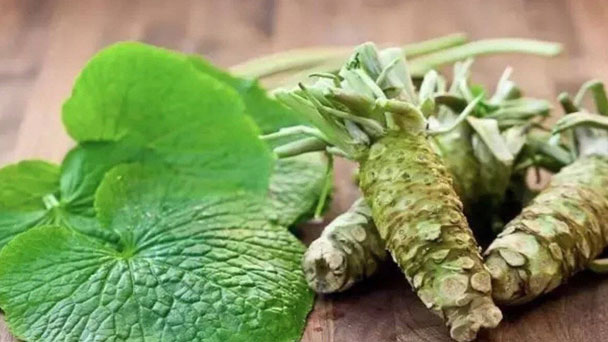
Horseradish is a hardy perennial with a pungent root that is long and narrow, sometimes reaching 2 feet (0.6m) long. Plant the horseradish every year and the roots will become tough and fibrous in the second year. Horseradish is best grown in containers, and it can easily spread and easily get out of control. The horseradish will be ready for harvest 140 to 160 days after planting.
Please note that these plants need fertile soil with a neutral pH to grow successfully. Make sure it is in full sunlight for optimum growth. A 3-inch layer of organic mulch will keep the soil moist and reduce weed growth, but keep it a few inches away from the base of the plant.
Horseradish plants have a habit of spreading, so you don't need more than two root pieces to produce enough for your entire household.
When planting, prepare the soil at least 10-12 inches deep and add compost and sand to keep the soil rich and loose. If planted in elevated beds, your plants should be spaced 18-24 inches deep to ensure enough room for root development.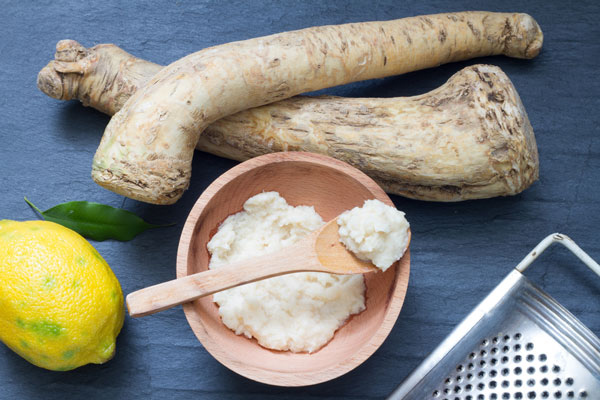
Whether you're growing horseradish from the crowns or the roots, it’s best to set them up nicely a few weeks prior to the last frost date. Make sure that you’re planting in USDA hardiness zones 3 to 9. This will ensure that the horseradish roots germinate successfully.
If you're growing horseradish in containers, the best time to transplant them to an outdoor garden is during the early growing season, just before new growth kicks off. You can also replant them once the season ends when you might be harvesting horseradish roots.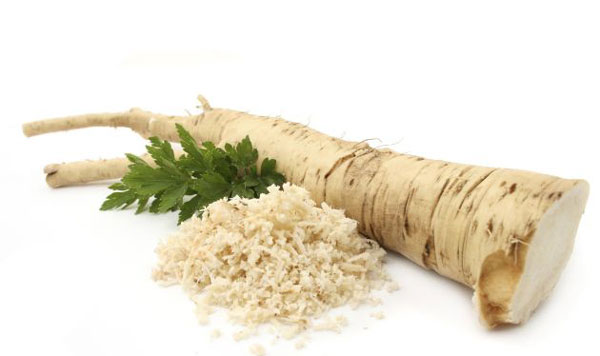
Plant the Crown cuttings upside down at an angle, with the top of the cutting about 2 inches below the ground. Spacing should be 2 to 2.5 feet apart in all directions.
Put some water in the hole with the cutting before covering it over. Once your cuttings are covered water them again thoroughly, be sure the water saturates the ground to a depth of about 3 or 4 inches.
Once watered place a healthy layer of organic mulch such as bark, wood chips, straw in the space between the plantings but leave a separation of an inch or two between the mulch and where the cuttings are planted.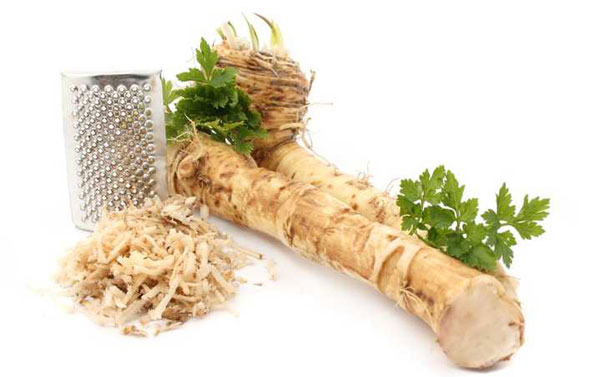
Horseradish flea beetle is a serious pest on foliage. It deposits egg clusters on leaf petioles (leafstalk). Its larvae burrow into the petioles and will kill some of the leaves. A floating row cover will help. Horticulture oils also have some repellent effect on this insect. Remember to read and follow the directions on all insecticides.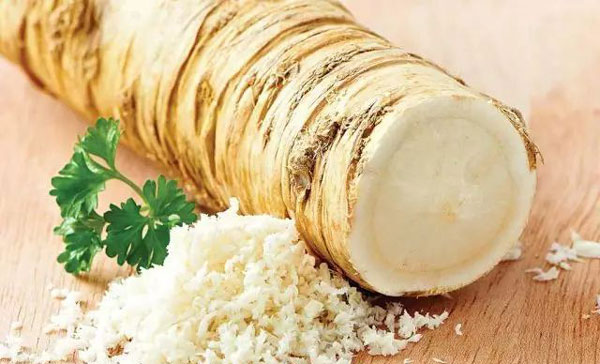
You'll know your horseradish is ready when its root is about 1-inch in diameter. You can check one of your roots by gently digging it from the ground. Replant it if it needs some time to grow. Horseradish typically takes a full year after planting to become established enough for harvesting. However, once it's established, you should continue to have excellent growth each year.
To harvest horseradish, use a digging fork to loosen the soil in a circle around the plant. Then, use your fingers to determine the angle of the root, so you can more easily follow its path to dig around it. Use your fork to help you gently pull up on the root from underneath.
Wash off each root and let them dry completely. You can then store them in the refrigerator in a perforated bag, preferably in the vegetable crisper section, for about 3 months.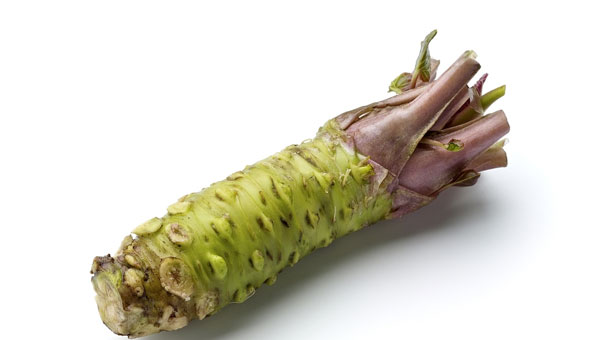
Where to Grow Horseradish PlantWhen to Grow Horseradish PlantHow to Grow Horseradish PlantHorseradish Propagation with Root CuttingsHorseradish Propagation with Crown CuttingsHow to Care for Horseradish PlantHorseradish Lighting RequirementsHorseradish Soil CareHorseradish WateringHorseradish Temperature CareHorseradish FertilizerHorseradish PruningHorseradish Pests & DiseasesHarvesting and Storing HorseradishVarieties of HorseradishHorseradish FAQMy roots arrived with a mold on them, will they be ok to plant?How long before I can harvest my horseradish?How do I get the hottest horseradish?Are the leaves of horseradish edible?
Where to Grow Horseradish Plant
Location is very important. Horseradish grows best in well-drained but moist, silty soil. These can be found naturally at the bottom of rivers. However, if you grow them in your backyard, you can use sandy loam or clay-rich plots.Please note that these plants need fertile soil with a neutral pH to grow successfully. Make sure it is in full sunlight for optimum growth. A 3-inch layer of organic mulch will keep the soil moist and reduce weed growth, but keep it a few inches away from the base of the plant.
Horseradish plants have a habit of spreading, so you don't need more than two root pieces to produce enough for your entire household.
When planting, prepare the soil at least 10-12 inches deep and add compost and sand to keep the soil rich and loose. If planted in elevated beds, your plants should be spaced 18-24 inches deep to ensure enough room for root development.

When to Grow Horseradish Plant
If you want new plants, you need to carefully choose the right soil and temperature conditions to ensure a successful harvest. The best time to start horseradish, especially in the United States, is spring.Whether you're growing horseradish from the crowns or the roots, it’s best to set them up nicely a few weeks prior to the last frost date. Make sure that you’re planting in USDA hardiness zones 3 to 9. This will ensure that the horseradish roots germinate successfully.
If you're growing horseradish in containers, the best time to transplant them to an outdoor garden is during the early growing season, just before new growth kicks off. You can also replant them once the season ends when you might be harvesting horseradish roots.

How to Grow Horseradish Plant
Horseradish Propagation with Root Cuttings
- Propagate horseradish in autumn in warmer Mediterranean-type climates. Water the plant thoroughly the evening before dividing the roots or crowns to ensure it is well-hydrated.
- Prepare a lightly shaded planting site. Remove any large pieces of debris from the soil and thoroughly weed the bed. Amend the soil to a 12-inch depth with a 4-inch-thick layer of compost and coarse sand.
- Lift the horseradish from the ground using a shovel or potato fork. Measure out 3 inches from the crown and dig down to a 10-inch depth. Pry the plant from the soil carefully to prevent root breakage.
- Crumble off the soil clinging around the roots. Rinse the roots thoroughly with a garden hose until all of the soil is gone. Lay them to dry in a shady spot for 15 to 20 minutes.
- Clean the blade of a gardening knife with hot, soapy water. Rub the blade with rubbing alcohol to eliminate any pathogens that might infect the horseradish roots. Wipe the blade dry with a paper towel.
- Create root cuttings by slicing the slender side roots into 6- to 8-inch-long portions, each with a diameter of approximately a 1/4 inch. Wipe the blade of the gardening knife after each cut to prevent infection.
- Create crown cuttings by slicing the horseradish plant into equal portions, each with an equal share of leafy shoots and roots. Discard any portions of the plant with damaged roots.
- Dig a planting hole for each root or crown cutting. Make the holes deep enough to accommodate the horseradish root. Space the holes 2 feet apart in rows that are 30 inches apart.
- Insert the horseradish root into the planting hole. Backfill around it with the amended soil until the root is completely covered and, in the case of crown cuttings, the base of the stems is even with the surrounding soil.
- Water each horseradish cutting to a 4-inch depth after transplant. Spread a 3-inch-thick layer of mulch between the cuttings. Leave a 1-inch space between the mulch and the horseradish plants to allow for moisture evaporation.
- Water weekly to a 1-inch depth during the winter months. Withhold all supplemental water during rainy weather to prevent rot. Wait until the top inch of soil is completely dry before adding more water.
Horseradish Propagation with Crown Cuttings
Crown cuttings are simpler than root cuttings. For crown cuttings, cut the plant into equal sections. All portions should have a fair share of both foliage and roots.Plant the Crown cuttings upside down at an angle, with the top of the cutting about 2 inches below the ground. Spacing should be 2 to 2.5 feet apart in all directions.
Put some water in the hole with the cutting before covering it over. Once your cuttings are covered water them again thoroughly, be sure the water saturates the ground to a depth of about 3 or 4 inches.
Once watered place a healthy layer of organic mulch such as bark, wood chips, straw in the space between the plantings but leave a separation of an inch or two between the mulch and where the cuttings are planted.

How to Care for Horseradish Plant
Horseradish Lighting Requirements
In general, horseradish is a forgiving plant that can handle a wide range of sun exposure. Ideally, however, horseradish thrives in full sun or part shade.Horseradish Soil Care
Horseradish likes a slightly acidic to neutral soil pH of about 6.0 to 7.5. A loose soil rich in organic matter will produce the best roots.Horseradish Watering
Horseradish is not a demanding plant, but you will get better-quality roots if you keep the soil well-watered, so the roots do not get woody.Horseradish Temperature Care
It prefers a temperature between 45-75 degrees Fahrenheit. Horseradish is cold-hardy, but it’s extremely sensitive to excessive heat. Keep an eye on the temperature. It shouldn’t exceed 75 degrees Fahrenheit. If it does, provide some shade by hanging shade cloth over the plants, or move them to a cooler location.Horseradish Fertilizer
Fertilize in the spring, using a low-nitrogen and high-phosphorus fertilizer for larger, healthier roots. If you’ve amended the soil heavily with compost, you may be able to skip fertilizer entirely.Horseradish Pruning
Pruning horseradish is mostly unnecessary. It’s mainly done to keep the suckers from inhibiting the growth of the main shoots. Remove the sucker leaves when they’re 6-8 inches long. These leaves grow outside of the plant’s crown.Make sure to trim those only and leave the tight bunch of leaves that’s growing right from the crown’s center. That’s where you want growth to continue!Horseradish Pests & Diseases
The most common problem with horseradish is how to keep it from growing where you don't want it. It can become aggressive if not kept under control. To control the spread, remove the entire root, even the branches, when harvesting. Replant only the number of roots you want for the following season. Whatever you do, don't till up soil containing horseradish roots because you will risk spreading the plant all over the garden. Almost every little piece of root will sprout where it lies.Horseradish flea beetle is a serious pest on foliage. It deposits egg clusters on leaf petioles (leafstalk). Its larvae burrow into the petioles and will kill some of the leaves. A floating row cover will help. Horticulture oils also have some repellent effect on this insect. Remember to read and follow the directions on all insecticides.

Harvesting and Storing Horseradish
For best flavor, horseradish should be harvested in cooler months, as cool soil helps to produce its pungent taste. The optimal time to harvest horseradish for most regions is in late fall through early spring. This also gives you a large window in which to harvest your horseradish, so you don’t have to harvest a lot at one time and chance it spoiling.You'll know your horseradish is ready when its root is about 1-inch in diameter. You can check one of your roots by gently digging it from the ground. Replant it if it needs some time to grow. Horseradish typically takes a full year after planting to become established enough for harvesting. However, once it's established, you should continue to have excellent growth each year.
To harvest horseradish, use a digging fork to loosen the soil in a circle around the plant. Then, use your fingers to determine the angle of the root, so you can more easily follow its path to dig around it. Use your fork to help you gently pull up on the root from underneath.
Wash off each root and let them dry completely. You can then store them in the refrigerator in a perforated bag, preferably in the vegetable crisper section, for about 3 months.
Varieties of Horseradish
Common horseradish may be the only variety you will find. There is also Armoracia rusticana 'Variegata', which is more ornamental, with marbled leaves.
Horseradish FAQ
My roots arrived with a mold on them, will they be ok to plant?
Yes, this is most likely a surface mold that will not affect the plants. It comes from the roots being in transit several days in warm conditions without adequate air circulation. If the roots are not mushy or do not have a foul odor, wash off the mold and plant.How long before I can harvest my horseradish?
Do not harvest horseradish the first year as this will weaken the plants. Wait until the end of the second year after planting to harvest.How do I get the hottest horseradish?
For the hottest horseradish, use the roots as soon as possible after harvest, the heat fades the longer the roots are stored. Roots should be creamy white when cut. The pungency also begins to wane when fresh crushed horseradish is exposed to air. When making your own sauce, add vinegar to stabilize the flavor about three minutes after grating. Add 2-3 tablespoons of white distilled vinegar and ½ teaspoon of salt to each cup of grated root.Are the leaves of horseradish edible?
Yes, the fresh leaves may be used in salads.Latest Updated
- Benefits of Bugleweed - 7 Science-backed Health Benefits
- Bugleweed Dangers & Side Effects - Is It Poisonous?
- How to Plant Evergreen Trees - What You Should Know
- When to Plant Evergreens - Grow Guide for Evergreen Trees
- 12 Wonderful Evergreen Shrubs for Your Garden
- 12 Popular Evergreen Plants with Pictures for Beginners
- When And How To Prune A Lilac Bush Like a Pro
- How to Grow & Care for Lilac Vine (Hardenbergia Violacea)
- Japanese Lilac Tree (Syringa Reticulata) Care & Propagation Guide
- Shumard Oak Pros and Cons - What to Know
Popular Articles
- Winter maintenance of Antirrhinum Majus
- How to Grow Terminalia Mantaly Tree
- How to Grow and Care for Crossostephium Chinense
- How to grow Antirrhinum Majus in spring
- Peristeria Elata (Dove Orchid) Profile: Info & Care Guide
- Underwatered Snake Plant (Sansevieria Trifasciata) - Signs And How To Fix
- How to Care for Brazilian Jasmine Plant (Mandevilla Sanderi)
- How to Grow & Care for Graptopetalum Purple Delight in Summer
- Rosa Chinensis (China Rose): Plant Growing & Care Tips
- How to Care for Baby Sun Rose (Aptenia Cordifolia)